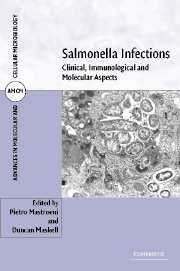Book contents
- Frontmatter
- Contents
- List of contributors
- Preface
- 1 Epidemiological and clinical aspects of human typhoid fever
- 2 Antibiotic resistance in Salmonella infections
- 3 Host-specificity of Salmonella infections in animal species
- 4 Public health aspects of Salmonella enterica in food production
- 5 The Salmonella genome: a global view
- 6 Pathogenicity islands and virulence of Salmonella enterica
- 7 In vivo identification, expression and function of Salmonella virulence genes
- 8 Mechanisms of immunity to Salmonella infections
- 9 Interactions of S. enterica with phagocytic cells
- 10 Interactions between Salmonella and dendritic cells: what happens along the way?
- 11 Immunity to Salmonella in domestic (food animal) species
- 12 Newer vaccines against typhoid fever and gastrointestinal salmonelloses
- 13 S. enterica-based antigen delivery systems
- Index
- Plate section
- References
11 - Immunity to Salmonella in domestic (food animal) species
Published online by Cambridge University Press: 04 December 2009
- Frontmatter
- Contents
- List of contributors
- Preface
- 1 Epidemiological and clinical aspects of human typhoid fever
- 2 Antibiotic resistance in Salmonella infections
- 3 Host-specificity of Salmonella infections in animal species
- 4 Public health aspects of Salmonella enterica in food production
- 5 The Salmonella genome: a global view
- 6 Pathogenicity islands and virulence of Salmonella enterica
- 7 In vivo identification, expression and function of Salmonella virulence genes
- 8 Mechanisms of immunity to Salmonella infections
- 9 Interactions of S. enterica with phagocytic cells
- 10 Interactions between Salmonella and dendritic cells: what happens along the way?
- 11 Immunity to Salmonella in domestic (food animal) species
- 12 Newer vaccines against typhoid fever and gastrointestinal salmonelloses
- 13 S. enterica-based antigen delivery systems
- Index
- Plate section
- References
Summary
INTRODUCTION
Salmonellosis in domestic animal species is important in terms of animal welfare and productivity. Infection may lead to decreased yields of milk, eggs or meat, and in certain cases loss of livestock. Salmonellosis in domestic species is also important for public health as the major reservoir and source of food-borne human infections.
A number of Salmonella enterica serovars can induce a systemic typhoid-like disease in healthy adults of a restricted range of host animal species. Other serovars colonize the intestine of the host and in some cases may induce severe enteritis. The severity of the disease will be dependent on the virulence and dose of the challenge and immune status of the host. Thus, some S. enterica strains that would normally induce enteritis in adult hosts are able to induce systemic disease in immuno-compromised hosts. Immunity to S. enterica is dependent on the nature of the disease that different serovars induce in different hosts. Thus, mucosal immunity is more likely to be important in protecting against serovars that induce enteritis, whereas systemic immunity would be more important in protecting against serovars that induce systemic disease.
Our understanding of the interaction of the host's immune system with different S. enterica serovars is still rudimentary. Effective control of salmonellosis affecting domestic host species requires a greater understanding of immunological mechanisms during such infections. This will provide the basis from which rational control measures, such as more effective vaccines, vaccination strategies, diagnostic tools or other non-immunological tools may be developed.
- Type
- Chapter
- Information
- Salmonella InfectionsClinical, Immunological and Molecular Aspects, pp. 299 - 322Publisher: Cambridge University PressPrint publication year: 2006

